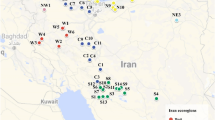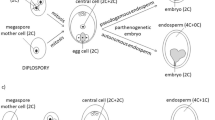Abstract
Kentucky bluegrass (Poa pratensis L.) is an important turf and forage grass species with a facultative apomictic breeding behavior. In this study, mature seed and leaf tissue from 38 accessions of a USDA core collection of Kentucky bluegrass were analyzed with flow cytometry to characterize the reproductive mode and DNA content for each accession. Major reproductive pathways for each accession were determined based upon the presence and the position of the peaks observed and the known methods of reproduction for Kentucky bluegrass. While the majority of the accessions exhibited facultative apomictic reproductive behavior with a combination of reduced, zygotic and unreduced, parthenogenic embryo production, obligate sexual or obligate apomictic accessions were also found to be present in this core collection. In addition, reduced, parthenogenic and unreduced zygotic embryos were also detected in several accessions. Flow cytometric analysis of somatic tissue revealed a large range of DNA variation within this core collection. We also examined the sensitivity of flow cytometry in analyzing bulked samples containing a large number of plants with varied DNA content and determined that flow cytometry can effectively detect a plant having a different DNA content within a 15-plant bulk sample. Overall the combination of mature seed and somatic tissue analysis generated important information for the Kentucky bluegrass core collection and can be an effective and affordable tool to characterize even greater numbers of Kentucky bluegrass accessions.
Similar content being viewed by others
References
E. Akerberg, Apomictic and sexual seed formation in Poa pratensis. Hereditas 25 (1939) 359-370
E. Akerberg, Cytogenic studies in Poa pratensisits hybrid with Poa alpine. Hereditas 28 (1942) 1-125
K. Arumuganathan, S.P. Tallury, M.L. Fraser, A.H. Bruneau and R. Qu, Nuclear DNA content of thirteen turfgrass species by flow cytometry. Crop Sci. 39 (1999) 1518-1521
E.C. Bashaw and C.R. Funk, Apomictic grasses. In: W.R. Fehr (ed.) Principles of Cultivar Development. Vol. 2 Crop Species. New York, NY: Macmillan Publishers (1987) pp. 40-82
J. Clausen, Introgression facilitated by apomixes in polyploid Poas. Euphytica 10 (1961) 87-94
J.M. Herr Jr., A new clearing-squash technique for the study of ovule development in angiosperms. Am. J. Bot. 58 (1971) 785-790
D.R. Huff and J.M. Bara, Determining genetic origins of aberrant progeny from apomictic Kentucky bluegrass using a combination of flow cytometry and silver stained RAPD markers. Theor. Appl. Genet. 87 (1993) 201-208
P.G. Johnson, T.P. Riordan and K. Arumuganathan, Ploidy level determinations in buffalograss clones and populations. Crop Sci. 38 (1998) 478-482
R.C. Johnson, W.J. Johnston, C.T. Golob, M.C. Nelson and R.J. Soreng, Characterization of the USDA Poa pratensis collection using RAPD markers and agronomic descriptors. Genet. Resour. Crop Evol. 27 (2002) 265-284
M.A. Lopes and B.A. Larkins, Endosperm origin, developmentand function. Plant Cell 5 (1993) 1383-1399
F. Matzk, A. Meister and I. Schubert, An efficient screen for reproductive pathways using mature seeds of monocots and dicots. Plant J. 21 (2000) 97-108
A. Mazzucato, M. Wagenvoort and T.P.M. Den Nijs, Flow cytometric analyses to estimate the mode of reproduction in Poa pratensis L. Apomixis Newslett. 7 (1994) 22-24
L. Schweizer, G.L. Yerk-Davis, R.L. Phillips, F. Srienc and R.J. Jones, Dynamics of maize endosperm development and DNA endoreduplication. Proc. Natl. Acad. Sci. USA 92 (1995) 7070-7074
Stephens L.C., Fei S., Xiong Y. and Hodges C.F. 2003. Plants regenerated from embryo cultures of an apomictic clone of Kentucky bluegrass (Poa pratensis L. cv. Baron) are disproportionately sexual in origin. Euphytica submitted2004.
B.A. Young, R.T. Sherwood and E.C. Bashaw, Cleared-pistil and thick-sectioning techniques for detecting aposporous apomixes in grasses. Can. J. Bot. 57 (1979) 1668-1672
T.E. Young and D.R. Gallie, Programmed cell death during endosperm development. Plant Mol. Biol. 44 (2000) 283-301
Author information
Authors and Affiliations
Corresponding author
Rights and permissions
About this article
Cite this article
Wieners, R.R., Fei, Sz. & Johnson, R.C. Characterization of a USDA Kentucky Bluegrass (Poa pratensis L.) Core Collection for Reproductive Mode and DNA Content by Flow Cytometry. Genet Resour Crop Evol 53, 1531–1541 (2006). https://doi.org/10.1007/s10722-005-7766-0
Received:
Accepted:
Published:
Issue Date:
DOI: https://doi.org/10.1007/s10722-005-7766-0




